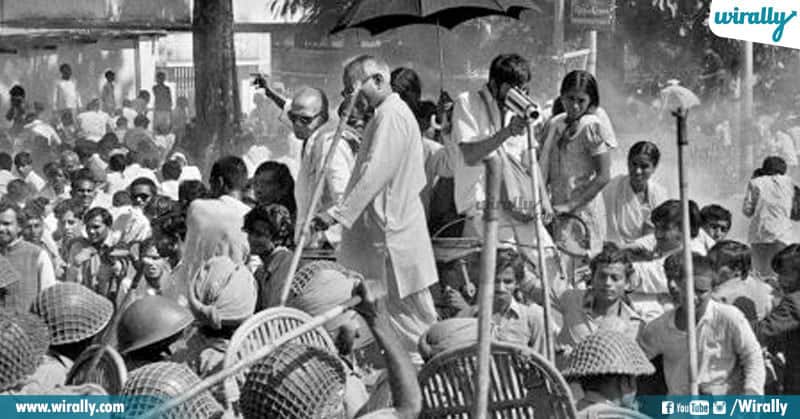India witnessed one of the darkest phases since Independence when the then Prime Minister Indira Gandhi declared an emergency across the country. ‘The Emergency’ spanning for 21 months came to effect from June 25, 1975 and lasted until March 21, 1977. But how many of us are aware of what exactly happened at that time, once you get to know the whole history of that dark phase of India, you will feel the chills run down your spine.
So here are the 10 shocking facts about worst phase in the Indian History:
1) What exactly was the Emergency?
 The Emergency is the kind of ruling generally done by monsters and dictators, whereby the follow countrymen have no rights on their own.
The Emergency is the kind of ruling generally done by monsters and dictators, whereby the follow countrymen have no rights on their own.
2) Why did Indira impose Emergency?
Indira’s Congress won 352 seats in the 1971 elections, and her rivals led by the likes of Morarji Desai were decimated. Success in the Bangladesh war followed. Although she remained unchallenged in her party and in Parliament, the mood of the public changed soon afterward — triggered by inflation caused by the 1973 oil shock, poor management of food grains and commodities, rising unemployment, and increasing corruption in government. Trade union militancy peaked with the 1974 railway strike. Agitating students in Bihar were backed by the Gandhian JP, who came out of retirement to give a call for Total Revolution. In June 1975, the combined opposition, with the blessings of JP, won the Gujarat assembly polls.
 On June 12, Allahabad High Court ruled on a petition filed by Bharatiya Lok Dal leader Raj Narain, declaring Indira’s election win from Rae Bareli void. As the Opposition called for her resignation, the PM appealed to the Supreme Court. The vacation bench of Justice V R Krishna Iyer gave a conditional stay on the HC order, ruling that she could remain PM, but could not speak or vote in Parliament pending a decision by a larger bench.
On June 12, Allahabad High Court ruled on a petition filed by Bharatiya Lok Dal leader Raj Narain, declaring Indira’s election win from Rae Bareli void. As the Opposition called for her resignation, the PM appealed to the Supreme Court. The vacation bench of Justice V R Krishna Iyer gave a conditional stay on the HC order, ruling that she could remain PM, but could not speak or vote in Parliament pending a decision by a larger bench.
On June 25, at a massive rally in Delhi, JP announced a weeklong Satyagraha to press for Indira’s resignation. He also appealed to the armed forces, police and government employees not to obey the “illegal and immoral orders” of the government. That night, Indira Gandhi, reportedly on the advice of then West Bengal Chief Minister S S Ray, decided to act. The Cabinet was not consulted. At 8 am on June 26, she made an unscheduled radio broadcast to tell the nation about the Emergency. Many newspapers in Delhi had had power supply cut off the previous night, and had not reached readers. They reported the news on June 27.
3) This was the third ‘Emergency’ since independence, the other two times were 1962-1968 (India – China War) and 1971 (Indo – Pak War)
 4) ‘The Emergency’ spanning for 21 months came to effect from June 25, 1975 and lasted until March 21, 1977.
4) ‘The Emergency’ spanning for 21 months came to effect from June 25, 1975 and lasted until March 21, 1977.
 5) During emergency censorship played a huge role. It was imposed on the press, cinema and other forms of art, and political leaders were being arrested at the whim and fancy of the government.
5) During emergency censorship played a huge role. It was imposed on the press, cinema and other forms of art, and political leaders were being arrested at the whim and fancy of the government.
 6) The media suffered the most, everything that went in papers would first be screened by the government. Political leaders and protestors started going underground.
6) The media suffered the most, everything that went in papers would first be screened by the government. Political leaders and protestors started going underground.
 7) Indira Gandhi re-wrote the law stating that existing laws are too slow. This behaviour of her was criticized heavily.
7) Indira Gandhi re-wrote the law stating that existing laws are too slow. This behaviour of her was criticized heavily.
 8) Evertime the Supreme Court ordered something against the government, Indira Gandhi changed the laws and many human rights were violated and the most gruesome of it all was the mass sterlisation campaign by her son Sanjay Gandhi.
8) Evertime the Supreme Court ordered something against the government, Indira Gandhi changed the laws and many human rights were violated and the most gruesome of it all was the mass sterlisation campaign by her son Sanjay Gandhi.
 9) Sanjay Gandhi, in the name of family planning castrated numerous people. Particularly Musilms had suffered most in the hands of Sanjay Gandhi.
9) Sanjay Gandhi, in the name of family planning castrated numerous people. Particularly Musilms had suffered most in the hands of Sanjay Gandhi.
 10) The First Lok Sabha election that took place after the emergency in 1977 saw Janatha Party oust the Gandhis.
10) The First Lok Sabha election that took place after the emergency in 1977 saw Janatha Party oust the Gandhis.



















